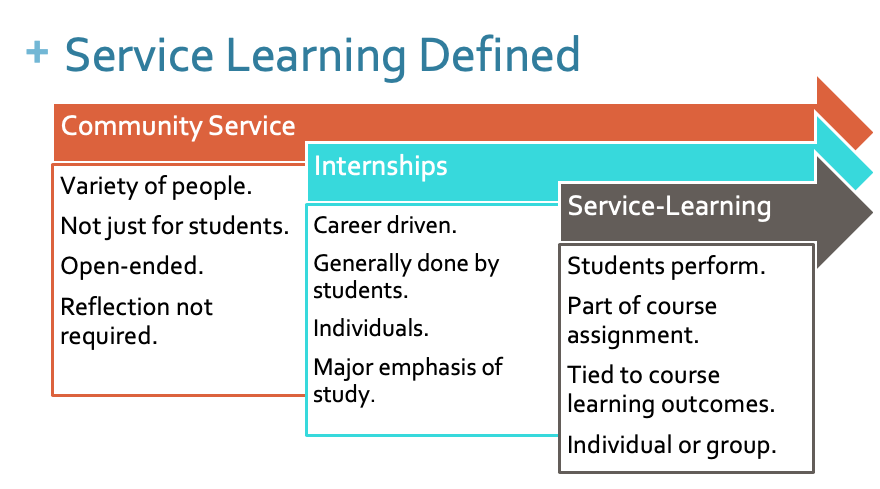 Online Service Learning: Projects for Students
Online Service Learning: Projects for Students
& Nonprofits
At first glance, it may appear that service learning is not naive but now outdated – nice to have, but not at all possible given the current chaos surrounding back-to-school plans and safety dilemmas during the global COVD-19 pandemic.
But, I’d argue that these opportunities are more important than ever … to both students and nonprofits, particularly if they can be developed to be completed remotely.
While it’s not clear how many high schools will require service learning for its students in the upcoming academic year, colleges and universities will still look for these types of experiences in applications from prospective students. Now, more than ever, volunteer service will be a competitive edge for many, providing proof of students’ grit and community spirit, despite all the odds.
In addition, some college scholarship programs still require service hours, going to the point of offering ways to log needed hours by watching videos. While this flexibility helps students meet the requirement, it does little to help promote the personal and social transformative learning that can only come about through real volunteer opportunities and the lived experiences that accompany them.
For nonprofits, service learning projects, even with the stresses of COVID-19, can be beneficial as well. The ability to work with a group of volunteers who have 1) dedicated time in their schedules for projects and 2) have the required skills and familiarity with online education and communications to work virtually with minimal obstacles, can be a real plus for resource-strapped organizations.
What’s more, these special projects can offer nonprofit staff the opportunity to pull in added support for administrative projects that have long been put on the back burner and are now being re-energized as on-site volunteer engagement has become limited.
For both students and organizations, the ability for staff and young people to interact and make progress together can help combat feelings of isolation for home-bound people. Fresh perspectives on and meaningful work, over a time-limited period, can offer a foil to the anxiety and stress of uncertainty for both parties.
Finally, service learning offers students who are interested in a nonprofit or public sector career the chance to experience the work from the “front lines,” observe how nonprofits are structured and function, learn more about staff roles, and decide if pursuing a career in the third sector makes sense.
The key is that these projects be developed with the end-user in mind – the youth or young adult.
Service Learning Defined
Safety from disease transmission is an ongoing concern for many, and virtual projects can offer peace of mind through remote work.
However, for projects to be successful and to be of value to both students and volunteer organizations, they must be designed well.
First up is to develop a clear understanding of what service learning is, and what it isn’t.
According to SOURCE, the community engagement and service-learning center for the Johns Hopkins University (JHU) Schools of Public Health, Nursing, and Medicine, service learning is defined as …
“a structured learning experience that combines community service with preparation and reflection. Students engaged in service-learning provide community service in response to community-identified concerns and learn about the context in which service is provided, the connection between their service and their academic coursework, and their roles as citizens.”
Many leaders of volunteers characterize service learning as “voluntary service in the community by students.” While this may be partly true, it is not the same as traditional community service. To identify as service learning, there must be an academic or curriculum component.
In addition, while students may be engaged in service for academic credit, they do not receive course credit for their volunteer hours. Instead, course credit is awarded upon the successful completion of the students’ coursework that accompanies the volunteer experience.
Service learning is much like an unpaid student internship. Internships are more individualized and focused on career paths. And, while it’s ideal that service can be anything the student is interested in the reality is that Not always possible to match student interests with community needs.
Service Learning vs. Other Opportunities

While the students should have a choice over the community agency they want to work with, not all organizations offer these opportunities, leaving fewer options on the table.
Whatever the available and chosen placement, all service learning students should be working within the framework of a course and the learning outcomes. And, those learning outcomes should be tied to a community work and course plan.
Finally, there is often the misunderstanding that the student work must be done by a group and not an individual or that these projects are the same as “days of service.” While this may sometimes be the case, individual projects are acceptable and may offer a better, more tailored learning experience.
Designing for Meaningful Service Learning
While research has shown the potential positive outcomes of service learning for students in higher education, these results have not been equal for all students.
In fact, for students from underrepresented groups (students of color, first-generation college students, and students from low-income economic backgrounds), service learning has offered mixed results. And researchers argue that the design of service learning must be carefully considered so that all students can benefit. However, more research needs to be conducted in this area.
Despite the lack of research, service learning can be a productive pathway toward more inclusive volunteerism that welcomes people from all walks of life and backgrounds.
For service learning in general, several elements have shown to promote positive academic achievement. The University of Georgia recommends the following five elements of service learning best practices:
- Service Activity or Project
Service-learning courses should include a service activity that is relevant to the course’s learning goals and supplies benefit to the community. The volunteer work can be direct (e.g., tutoring) or indirect (e.g., developing a website or creating a report).
- Community Partnerships
Service learning placements are made with the input of the community agency, which should also help name the need to be addressed and the role students and instructors will play. Every project should be mutually beneficial.
- Learning
Course credit is given for the achievement of stated academic learning goals. In addition, students often gain personal and civic growth, development of which can be built into the course curriculum.
- Self-Reflection
The transformative nature of service learning is fostered using critical reflection activities that must be integrated into the course. These can occur before, during, and after the service placement (asking What? So what? Now what?). Reflection can be fostered through a variety of means including written journaling, small-group discussions, multimedia work, portfolios, presentations, poster sessions, podcasts, blogs, etc.
- Structure
Service learning courses can take place at any level from pre-secondary to secondary, to graduate work. Given the proper design, and a solid academic foundation and goals, any student can benefit. Projects can take place for a single day to a full semester, to a full academic year.
The bonus, given the current pandemic, is that service learning projects can take place online or in-person, making them a wonderful choice for students during a pandemic when they may be either telecommuting to school by choice or working from home due to quarantine.
They also help the organization by offering talent that is focused, motivated, and equipped to take advantage of the opportunities.
Ideas for Virtual Service Learning Projects
 If you’re excited about the prospect of developing service learning projects, below is a list of ideas. While not exhaustive, it may trigger other ideas for you.
If you’re excited about the prospect of developing service learning projects, below is a list of ideas. While not exhaustive, it may trigger other ideas for you.
Also, remember, that this is not a “set it and forget it” enterprise. Students will need support, guidance, a clear project plan, and some interaction and coaching with you. If you dedicate time to developing a quality project, you will be more likely to get quality results.
Consider which student interests, departments, or majors might best align with the projects you offer. That can help you decide which departments or faculty to approach with a proposal to partner.
The good news is that these projects can also be repeated semester after semester if the need still exists for your organization. What’s more, some of the foundational elements, such as student agreements and orientation training, can be re-purposed repeatedly.
Virtual Project Ideas
Below are some project ideas and topics of study where they might be helpful to student learning.
- Design and conduct a volunteer satisfaction survey (or pulse surveys) and analyze the results (social sciences)
- Help organizations maximize their financial processes, prepare taxes, perform audits, etc. (accounting)
- Prepare media releases for programming and upcoming events (public relations)
- Update the website and build out list-building opportunities (digital communications)
- Tutor children, or read to them or with them, online (education)
- Develop curriculum and coach seniors on how to use technology (information technology)
- Tutor others in English as a Second Language or in their language (English or foreign languages)
- Write newsletters and blog posts for the organization and manage an editorial calendar (marketing & communications)
- Perform research and write policy briefs that explain the organization’s policy stance (public administration)
- Develop graphic design elements or re-branding for the organization (graphic arts)
- Perform a communications audit and competitor analysis for the organization (marketing)
- Research and create ideal donor profiles or avatars (business)
- Analyze program outcome data and create reports for funders (mathematics)
- Develop and deliver self-help curricula to promote healthier habits in the agency’s clients (public health)
- Present new volunteer trainings and orientations (nonprofit studies)
- Develop an improved onboarding process for volunteers (human resources)
- Design and create a playground for a community organization (mechanical engineering)
- Supply crisis counseling services via text and rape prevention education via online seminar (women’s studies)
As you can see, the sky’s the limit in terms of ideas. You might also reach out to your local universities to explore the learning needs they have and how they might intersect with your program needs.
Resources to Further Your Learning
While most of these resources are developed for instructors and faculty who wish to develop curriculum, they are nonetheless helpful for nonprofit staff to review to better understand the needs of their prospective partners before they reach out to collaborate.
Here are a few:
- Intro to Service-Learning Toolkit: Readings – http://www.wcsu.edu/community-engagement/wp-content/uploads/sites/29/2018/05/Intro.-to-Service-Learning-Tool-Kit-Readings-Resources-for-Faculty.pdf
- National Youth Leadership Council (formerly National Service-Learning Clearinghouse) – https://www.nylc.org/
- Johns Hopkins University Service Learning Toolkit – https://source.jhu.edu/publications-and-resources/service-learning-toolkit/
- Good Character Service Learning Resources for K-12 — https://www.goodcharacter.com/service-learning/
- Youth.gov Guides for COVID-19 – https://youth.gov/section/tools-guides
- Youth-driven Education & Career Toolkit — https://engage.youth.gov/career-pathways
- University of Kansas Service Learning MOU Sample – https://csl.ku.edu/sites/csl.ku.edu/files/docs/UNIV492%20Service%20Learning%20Agreement_Final.pdf
- National Geographic Service Learning Toolkit for Activities Indoors & Out – https://www.nationalgeographic.org/media/service-learning-toolkit/
There are plenty of reasons that incorporating student volunteering makes sense, even now. Here are only a few student, nonprofit, and community results that make it an excellent addition to your current menu of volunteer roles.
- Student Success – Educated students mean our workforce will get stronger.
- Community Impact – With more help, you can support more programs and services for unmet needs.
- Volunteer Development – If volunteers enjoy their experiences, they tell others and support your organization into their work-life through contributions of time and funds.
- Strong Partnerships – When everyone wins – students, schools, and nonprofits – faculty will return repeatedly to work with you and supply talent for your projects. You won’t have to re-invent the wheel.
- Newsworthy – Leveraging resources is impressive and students working for you can attract good attention from local media which, in turn, shows your relevance and value to current and future funders.
With all these benefits, what do you have to lose?
What projects do you have in mind? Share them with us in the comments below.







Leave A Comment